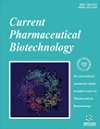- Home
- A-Z Publications
- Current Pharmaceutical Biotechnology
- Previous Issues
- Volume 12, Issue 9, 2011
Current Pharmaceutical Biotechnology - Volume 12, Issue 9, 2011
Volume 12, Issue 9, 2011
-
-
Opportunities for Pharmacotherapy at the Intersection of Metabolic Syndrome and Hemostasis
More LessAuthors: Laura F. Michael, Veena Rao, Patrick McCollam, Mark C. Kowala and John WetterauHemostatic balance is regulated by many factors that may become perturbed by cardio-metabolic abnormalities. Indeed, patients with multiple components of the metabolic syndrome have increased risk of atherosclerosis, hemostatic disorders and thrombotic events. This review focuses on the interrelationship between the metabolic syndrome components and thrombotic and thromboembolic events, the potential underlying mechanisms that lead to metabolic and hemostatic disorders in metabolic syndrome patients, the existing therapeutics aimed at reducing major cardiovascular events, and new therapeutic approaches to address pro-coagulant states.
-
-
-
Therapeutic Modulation of Coagulation and Fibrinolysis in Acute Lung Injury and the Acute Respiratory Distress Syndrome
More LessAuthors: Sara C. Sebag, Julie A. Bastarache and Lorraine B. WareAcute respiratory distress syndrome (ARDS) and acute lung injury (ALI) are characterized by excessive intraalveolar fibrin deposition, driven, at least in part by inflammation. The imbalance between activation of coagulation and inhibition of fibrinolysis in patients with ALI/ARDS favors fibrin formation and appears to occur both systemically and in the lung and airspace. Tissue factor (TF), a key mediator of the activation of coagulation in the lung, has been implicated in the pathogenesis of ALI/ARDS. As such, there have been numerous investigations modulating TF activity in a variety of experimental systems in order to develop new therapeutic strategies for ALI/ARDS. This review will summarize current understanding of the role of TF and other proteins of the coagulation cascade as well the fibrinolysis pathway in the development of ALI/ARDS with an emphasis on the pathways that are potential therapeutic targets. These include the TF inhibitor pathway, the protein C pathway, antithrombin, heparin, and modulation of fibrinolysis through plasminogen activator- 1 (PAI-1) or plasminogen activators (PA). Although experimental studies show promising results, clinical trials to date have proven unsuccessful in improving patient outcomes. Modulation of coagulation and fibrinolysis has complex effects on both hemostasis and inflammatory pathways and further studies are needed to develop new treatment strategies for patients with ALI/ARDS.
-
-
-
Targeting the Coagulation Factor Fibrinogen for Arthritis Therapy
More LessAuthors: Harini Raghu and Matthew J. FlickFibrinogen is a provisional matrix protein of the coagulation system that following proteolytic cleavage by the protease thrombin polymerizes to form fibrin, the structural basis of the blood clot. Fibrin polymer formation at sites of vessel injury is critical to normal hemostasis. However, fibrin deposition within damaged tissues is also a common pathological feature of inflammatory diseases, including rheumatoid arthritis. Fibrin deposition has been readily detected along articular surfaces, within inflamed hyperplastic synovial tissue, and as a component of insoluble “rice bodies” within the synovial fluid of arthritic joints. Recent data has suggested that fibrin deposition within inflamed tissues is not simply a reflection of a disease process but rather actively contributes to disease pathogenesis. One mechanism that has been demonstrated to directly link fibrin(ogen) to the regulation of inflammation is the ability of fibrin(ogen) to serve as a ligand for cell-surface receptors, particularly integrins. Indeed, engagement of fibrin(ogen) by the leukocyte integrin receptor αMβ2 appears to be a common and fundamental event driving local inflammation. Recent studies have demonstrated that eliminating fibrin(ogen)-αMβ2 interactions can significantly limit the progression of multiple inflammatory diseases, including arthritis, without compromising the ability of fibrinogen to function in coagulation. These exciting findings have opened the door to new opportunities for targeting fibrinogen as an inflammatory mediator while leaving intact its hemostatic properties.
-
Volumes & issues
-
Volume 25 (2024)
-
Volume 24 (2023)
-
Volume 23 (2022)
-
Volume 22 (2021)
-
Volume 21 (2020)
-
Volume 20 (2019)
-
Volume 19 (2018)
-
Volume 18 (2017)
-
Volume 17 (2016)
-
Volume 16 (2015)
-
Volume 15 (2014)
-
Volume 14 (2013)
-
Volume 13 (2012)
-
Volume 12 (2011)
-
Volume 11 (2010)
-
Volume 10 (2009)
-
Volume 9 (2008)
-
Volume 8 (2007)
-
Volume 7 (2006)
-
Volume 6 (2005)
-
Volume 5 (2004)
-
Volume 4 (2003)
-
Volume 3 (2002)
-
Volume 2 (2001)
-
Volume 1 (2000)
Most Read This Month


